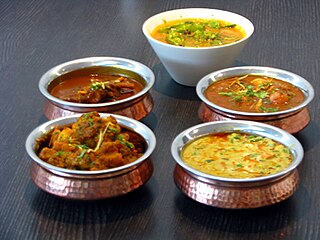
Curry is a variety of dishes originating in the Indian subcontinent that use a complex combination of spices or herbs, usually including ground turmeric, cumin, coriander, ginger, and fresh or dried chilies. Curry is generally prepared in a sauce. Curry dishes prepared in the southern states of India, where the word also originated, may be spiced with leaves from the curry tree.

Vietnamese cuisine encompasses the foods and beverages of Vietnam, and features a combination of five fundamental tastes in overall meals. Each Vietnamese dish has a distinctive flavor which reflects one or more of these elements. Common ingredients include shrimp paste, soy sauce, bean sauce, rice, fresh herbs, fruit and vegetables. French cuisine has also had a major influence due to the French colonization of Vietnam. Vietnamese recipes use lemongrass, ginger, mint, Vietnamese mint, long coriander, Saigon cinnamon, bird's eye chili, lime, and Thai basil leaves. Traditional Vietnamese cooking is greatly admired for its fresh ingredients, minimal use of dairy and oil, complementary textures, and reliance on herbs and vegetables. With the balance between fresh herbs and meats and a selective use of spices to reach a fine taste, Vietnamese food is considered one of the healthiest cuisines worldwide.

Nasi lemak is a Malay fragrant rice dish cooked in coconut milk and pandan leaf. It is commonly found in Malaysia, where it is considered the national dish; it is also the native dish in neighbouring areas with significant Malay populations such as Singapore; Brunei, and Southern Thailand. In Indonesia it can be found in several parts of Sumatra; especially Malay realm of Riau, Riau Islands and Medan. Nasi lemak can also be found in the Bangsamoro region of Mindanao prepared by Filipino Moro. It is considered one of the most famous dishes for a Malay-style breakfast. It is not to be confused with nasi dagang, sold in the Malaysian east coast states of Terengganu and Kelantan, although both dishes are often served for breakfast. However, because nasi lemak can be served in a variety of ways, it is often eaten throughout the day.
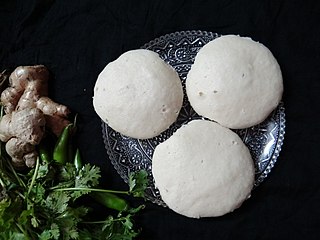
Idli or idly are a type of savoury rice cake, originating from the Indian subcontinent, popular as breakfast foods in southern India and among Tamils in Sri Lanka. The cakes are made by steaming a batter consisting of fermented black lentils (de-husked) and rice. The fermentation process breaks down the starches so that they are more readily metabolized by the body.

Fried rice is a dish of cooked rice that has been stir-fried in a wok or a frying pan and is usually mixed with other ingredients such as eggs, vegetables, seafood, or meat. It is often eaten by itself or as an accompaniment to another dish. Fried rice is a popular component of East Asian, Southeast Asian and certain South Asian cuisines. As a homemade dish, fried rice is typically made with ingredients left over from other dishes, leading to countless variations. Fried rice first developed during the Sui Dynasty in China and as such all fried rice dishes can trace their origins to Chinese fried rice.

Rice and curry is a popular dish in the Southern Indian states of Andhra Pradesh, Telangana, Karnataka, Kerala, and Tamil Nadu, as well as in Sri Lanka and Bangladesh.
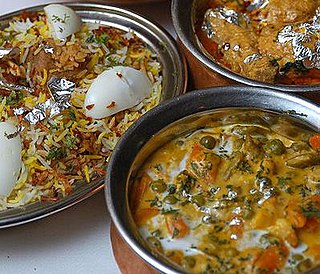
Biryani, also known as biriyani, biriani, birani or briyani, is a mixed rice dish with its origins among the Muslims of the Indian subcontinent. It can be compared to mixing a curry, later combining it with semi-cooked rice separately. This dish is especially popular throughout the Indian subcontinent, as well as among the diaspora from the region. It is also prepared in other regions such as Iraqi Kurdistan. It is made with Indian spices, rice, meat, vegetables or eggs.
Sri Lankan cuisine has been shaped by many historical, cultural and other factors. Contact with foreign traders who brought new food items, cultural influences from neighbouring countries as well as the local traditions of the country's ethnic groups among other things have all helped shape Sri Lankan cuisine. Influences from Indian, Indonesian and Dutch cuisines are most evident with Sri Lankan cuisine sharing close ties to other neighbouring South and Southeast Asian cuisines. Today, some of the staples of Sri Lankan cuisine are rice, coconut and spices. The latter are used due to the country's history as a spice producer and trading post over several centuries.

The culture of Sri Lanka mixes modern elements with traditional aspects and is known for its regional diversity. Sri Lankan culture has long been influenced by the heritage of Theravada Buddhism passed on from India, and the religion's legacy is particularly strong in Sri Lanka's southern and central regions. South Indian cultural influences are especially pronounced in the northernmost reaches of the country. The history of colonial occupation has also left a mark on Sri Lanka's identity, with Portuguese, Dutch, and British elements having intermingled with various traditional facets of Sri Lankan culture. Additionally, Indonesian culture has also influenced certain aspects of Sri Lankan culture. Culturally, Sri Lanka, particularly the Sinhalese people, possesses strong links to both India and Southeast Asia.

Sindhi cuisine refers to the native cuisine of the Sindhi people from Sindh, Pakistan. The daily food in most Sindhi households consists of wheat-based flat-bread (phulka) and rice accompanied by two dishes, one gravy and one dry with curd or pickel. Today, Sindhi food is eaten in many countries including India, where a sizeable number of Hindu Sindhis migrated following the independence in 1947.
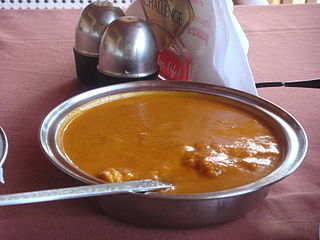
Goan cuisine consists of regional foods popular in Goa, an Indian state located along India's west coast on the shore of the Arabian Sea. Rice, seafood, coconut, vegetables, meat, pork and local spices are some of the main ingredients in Goan cuisine. The area is located in a tropical climate, which means that spices and flavors are intense. Use of kokum is another distinct feature. Goan food is considered incomplete without fish.

Padang food or Minang food is the cuisine of the Minangkabau people of West Sumatra, Indonesia. It is among the most popular food in Maritime Southeast Asia. It is known across Indonesia as Masakan Padang after the city of Padang the capital city of West Sumatra province. It is served in restaurants mostly owned by perantauan (migrating) Minangkabau people in Indonesian cities. Padang food is ubiquitous in Indonesian cities and is popular in neighboring Malaysia and Singapore.
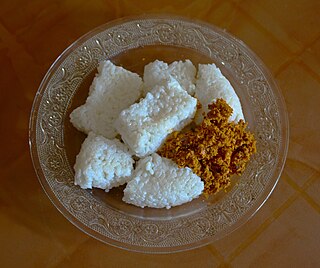
Kiribath is a traditional Sri Lankan dish made from rice. It is prepared by cooking rice with coconut milk, hence this name, and can be considered a form of rice cake or rice pudding. Kiribath is an essential dish in Sri Lankan cuisine. It is very commonly served for breakfast on the first day of each month and also has added significance of being eaten for any auspicious moment throughout one's lifetime which are marking times of transition. It is one of the more renowned traditional dishes in Sri Lanka.

Pol sambola is a traditional Sri Lankan dish made from coconut, mostly used as an accompaniment with rice, string hoppers, hoppers, parathas and curries. It is a coconut relish, consisting of freshly grated coconut, red onions, dried whole chilies, lime juice, salt and Maldive fish.

Telugu cuisine is a cuisine of South India native to the Telugu people from the states of Andhra Pradesh and Telangana. Generally known for its tangy, hot and spicy taste, the cooking is very diverse due to the vast spread of the people and varied topological regions.

Khanom chin are fresh, thin rice noodles in Thai cuisine which are made from rice sometimes fermented for three days, boiled, and then made into noodles by extruding the resulting dough through a sieve into boiling water. Khanom chin is served in many kinds of stock: coconut milk, fish curry, and chilli. Although chin means "Chinese" in Thai, this type of noodle originated from the Mon people who inhabited the region which is now central Thailand before the arrival of the Thai people from southern China. The word khanom chin is probably derived from the Mon words hanom cin, or "boiled noodles."

Kaeng tai pla is a curry of southern Thai cuisine. Its name is derived from tai pla, a salty sauce made from fermented fish entrails, which gives the curry a strong smell and flavor.
Khua kling is a main dish from the south of Thailand and has a spicy taste. The primary components are meat and curry paste. The ingredients are roasted and can be cooked easily.

Stir fried water spinach is a common Asian vegetable dish of stir-fried water spinach. It is a popular Asian vegetable dish, commonly found throughout East, South and Southeast Asia; from Sichuan and Cantonese cuisine in China, to Filipino, Indonesian, Malaysian, Singaporean, and Vietnamese cuisine in Southeast Asia; to Sri Lankan cuisine and Bengali cuisine in South Asia. As a result, it is known by many names; such as tumis kangkung or cah kangkung in Indonesia; kangkong goreng in Malaysia; ginisang kangkóng or adobong kangkóng in the Philippines; rau muống xào in Vietnam; stir fry kong xin cai (空心菜); stir fry tung choy or ong choy (通菜) in China; kankun mallung in Sri Lanka; and kolmi shak bhaja in Bangladesh and eastern India.

Seblak is a Southeast Asian savoury and spicy dish, originating from Indonesia, made of wet krupuk cooked with protein sources in spicy sauce. Seblak is a specialty of Bandung city, West Java, Indonesia. Seblak can be acquired from restaurants, warungs or gerobak (cart) street vendors. It is one of the most popular street foods in Indonesia, especially in Bandung and Jakarta.





















